Scientific Name:
- Gingko biloba
Species
- Gingko Biloba
Type of Tree
Bonsai Style:
Bonsai Tree Size:
This Ginko Biloba bonsai was donated by Bonsai Society member John Carroll in 1996.
It is a grove-style group planting. The pot is oval, unglazed, brown in color and is 2 inches deep.
Gingko biloba, commonly known as gingko or gingko, also known as the maidenhair tree, is a species of gymnosperm tree native to China. It is the last living species in the order gingkoales, which first appeared over 290 million years ago. Fossils very similar to the living species, belonging to the genus Gingko, extend back to the Middle Jurassic approximately 170 million years ago. The tree was cultivated early in human history and remains commonly planted.
One of the more interesting facts about gingko trees is that they can spontaneously change gender. This evolutionary adaptation allows ginkgoes to propagate when the sex ratio is imbalanced. This means that planting a male ginkgo does not guarantee that it won’t change to female and start developing stinky cones 30 years in the future.
Gingko leaf extract is commonly used as a dietary supplement, but there is no scientific evidence that it supports human health or is effective against any disease.
It is insect resistant. Not only that, it's resistant to air pollution, and can tolerate soil compaction, pests, disease, salt, wind, cold, drought, fire, and even nuclear blasts.

